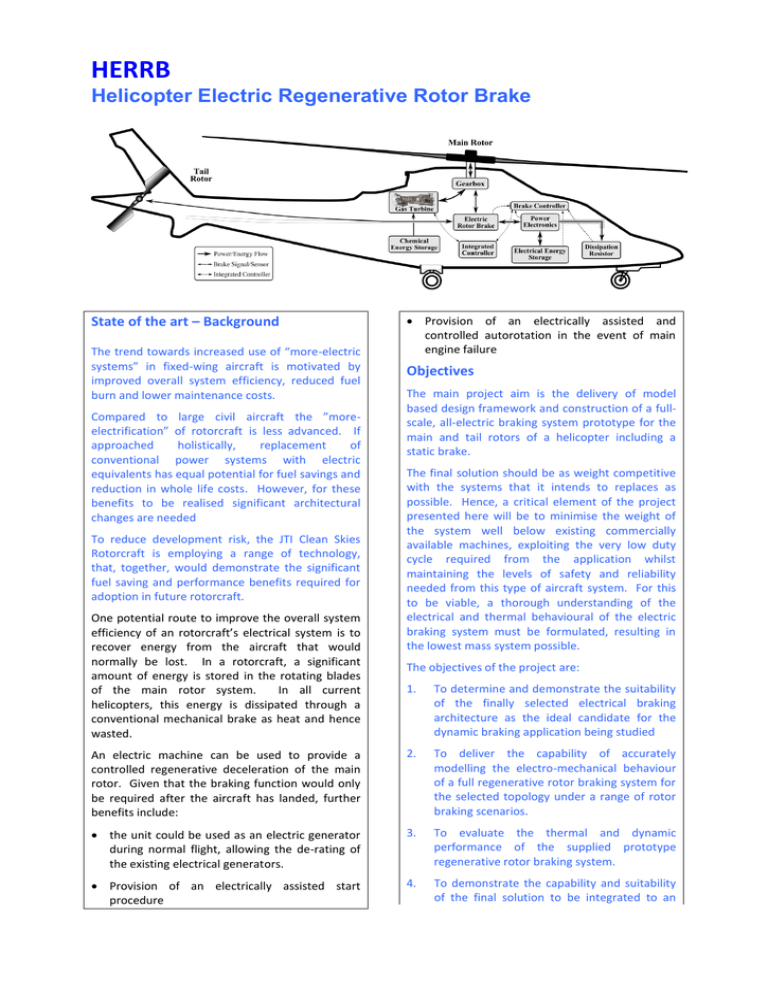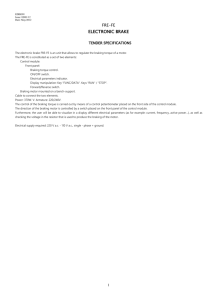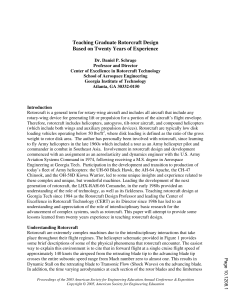Project Description
advertisement

HERRB Helicopter Electric Regenerative Rotor Brake State of the art – Background The trend towards increased use of “more-electric systems” in fixed-wing aircraft is motivated by improved overall system efficiency, reduced fuel burn and lower maintenance costs. Compared to large civil aircraft the ”moreelectrification” of rotorcraft is less advanced. If approached holistically, replacement of conventional power systems with electric equivalents has equal potential for fuel savings and reduction in whole life costs. However, for these benefits to be realised significant architectural changes are needed To reduce development risk, the JTI Clean Skies Rotorcraft is employing a range of technology, that, together, would demonstrate the significant fuel saving and performance benefits required for adoption in future rotorcraft. One potential route to improve the overall system efficiency of an rotorcraft’s electrical system is to recover energy from the aircraft that would normally be lost. In a rotorcraft, a significant amount of energy is stored in the rotating blades of the main rotor system. In all current helicopters, this energy is dissipated through a conventional mechanical brake as heat and hence wasted. Provision of an electrically assisted and controlled autorotation in the event of main engine failure Objectives The main project aim is the delivery of model based design framework and construction of a fullscale, all-electric braking system prototype for the main and tail rotors of a helicopter including a static brake. The final solution should be as weight competitive with the systems that it intends to replaces as possible. Hence, a critical element of the project presented here will be to minimise the weight of the system well below existing commercially available machines, exploiting the very low duty cycle required from the application whilst maintaining the levels of safety and reliability needed from this type of aircraft system. For this to be viable, a thorough understanding of the electrical and thermal behavioural of the electric braking system must be formulated, resulting in the lowest mass system possible. The objectives of the project are: 1. To determine and demonstrate the suitability of the finally selected electrical braking architecture as the ideal candidate for the dynamic braking application being studied An electric machine can be used to provide a controlled regenerative deceleration of the main rotor. Given that the braking function would only be required after the aircraft has landed, further benefits include: 2. To deliver the capability of accurately modelling the electro-mechanical behaviour of a full regenerative rotor braking system for the selected topology under a range of rotor braking scenarios. the unit could be used as an electric generator during normal flight, allowing the de-rating of the existing electrical generators. 3. To evaluate the thermal and dynamic performance of the supplied prototype regenerative rotor braking system. Provision of an electrically assisted start procedure 4. To demonstrate the capability and suitability of the final solution to be integrated to an existing rotorcraft’s transmission minimal design modifications. with the environment in which they are expected to operate, mechanically, electrically and thermally. Description of work Expected results The work can be broadly categorised into four main areas being covered by six distinct work packages. a) Timeline & main milestones WP1 & 2 will focus on the design and optimisation of the dynamic (or regenerative) aspect of the rotor brake. Detailed and coupled modelling of the thermal and electromagnetic and electric machine, power electronics based converter, heatsinks and emergency dissipation devices will drive the final design towards a minimum installed mass . The project started in October 2011 M04 (Jan ‘12) Detailed Specification Agreed M10 (Jul’12) Modelling tools finalised and trade studies for proposed architectures complete M13 (Oct ’12) Preliminary Design Review M22 (Jul ’13) Critical Design Review M26 (Nov ’13) System prototype constructed M29 (Feb ’14) System characterised and benefits demonstrated. b) Environmental benefits Capture and re-use of a significant amount energy on the rotorcraft that is current dissipated each time the aircraft is stopped. WP3 will consider the design of the electric static (or holding) brake from the concept stage right through to embodiment and final prototype. Unlike the dynamic brake, topological constraints exist on this aspect of the design resulting in a large solution space that must be methodically and objectively searched resulting in an integrated and optimum final outcome. WP4 & 5 will consider the designs proposed in WP 1, 2 & 3 and ensure that they meet as closely as possible at the prototype stage requirements for a modern rotorcraft in terms of packaging, integration, reliability and safety. Once the designs are complete WP6 will construct the final prototypes of the integrated static and dynamic electric braking systems and characterise them on a full scale test rig that emulates closely Potential for multiple uses, replacing existing equipment on the aircraft, reducing total system mass and thereby improving overall fuel efficiency of the aircraft. c) Maturity of works performed The work will result whose architecture, components would which could be demonstrating the operation. in a TRL 5 prototype system packaging, subsystems and be representative of those installed in an aircraft potential for flight worthy Project Summary Acronym : HERRB Name of proposal: Helicopter Electrical Regenerative Rotor Brake Technical domain: Aircraft Electrical Drives Involved ITD Green Rotorcraft Grant Agreement: Instrument: Clean Sky Total Cost: 698330€ Clean Sky contribution: 523748€ Call: JTI-CS-2011-01-GRC-03-007 Starting date: Oct 2011 Ending date: February 2014 Duration: 29 months Coordinator contact details: Dr. David Drury Room 5.03, Merchant Venturers Building Woodland Road, Bristol, BS8 1UB United Kingdom +44 (0) 117 954 5390 d.drury@bristol.ac.uk Project Officer: Sébastien Dubois sebastien.dubois@cleansky.eu Participating members UNIVERSITY OF BRISTOL UK MOTOR DESIGN LIMITED UK ADAPTED SOLUTIONS GmbH DE


